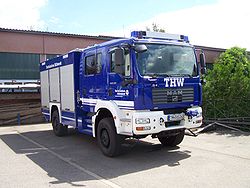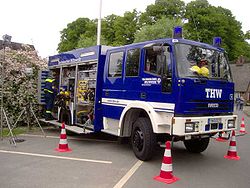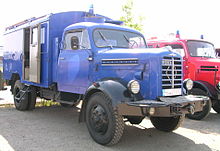Equipment vehicles
The equipment vehicle ( GKW for short ) is an emergency vehicle used by various authorities and organizations with security tasks in Germany, especially the Technical Relief Agency (THW).
Similar to the equipment vehicle rescue vehicles of the fire brigade. Even outside the technical relief organization, fire brigades and other aid organizations occasionally use equipment vehicles or develop them further according to their own needs. Despite the linguistic similarity, equipment vehicles are not to be confused with equipment vehicles that are subject to different standards and objectives.
history
The first generation of equipment vehicles was developed between 1956 and 1959 for the rescue service of the disaster control (first air raid service LSHD, later THW) in the then still young Federal Republic of Germany. Was used as a carrier vehicle Borg Ward B 4500 A, 1959 B 555 A with a four-wheel - chassis selected for 8800 kg gross vehicle weight with a mechanical front-mounted winch is equipped. As there was only room for three people including the driver in the driver's cab , seats (two of which were folding seats ) were provided for eight additional people in the special structure . The box body was given a single-leaf flap door with window that opened outwards at the rear and on each side, as well as an engine-independent heater. There were compartments, drawers, boxes and brackets accessible from both the inside and outside for the devices that were carried along. The specialist service equipment weighed around 1800 kg. The exterior color of the vehicle was initially khaki , later the chassis including fenders, bumper and rims were black, the driver's cab and body were painted ultramarine blue.
From 1957 to 1961 numerous GKW on Borgward chassis - initially with 95 hp diesel engines , later with 110 hp - were procured, the box bodies were manufactured by various body construction companies (including Kässbohrer ). Since the Borgward company went bankrupt in 1961 and ceased operations, a new supplier for the carrier vehicle had to be found. From 1962, the GKW were procured on Magirus-Deutz Mercur 120 AL with an air-cooled 120-hp diesel engine and a permissible total weight of 10,000 kg.
The 2nd generation (GKW 72) was designed in 1972, taking into account the previous experience with the previous GKW, for the necessary replacement needs of the first-generation GKW and the conversion of the tactical units of the disaster control from readiness to trains. These were given a double cabin with two rows of seats so that everyone could be accommodated here and the box body could only be used to accommodate the devices. These were now only accessible from the outside, whereby the three fold-down side walls, equipped with air spring counterbalance and covering the lower part of the device compartments, served as raised treads when folded down. The upper areas of the equipment compartments were closed by shutters . The cable winch was now hydraulic with automatic cable winding and had a maximum pulling force of 5 t .
The GKW 72 was procured in two production series: the first series with 61 vehicles from 1975 had a Daimler-Benz short- nosed all-wheel drive chassis with (initially) single-tire rear axles, a 130 HP diesel engine and a cable winch with max. 5 t train forward. The double cabin was manufactured by various body construction companies, the box body by the company Büssing und Sohn in Braunschweig.
The slightly changed second production series had a Magirus-Deutz 170 D 11 FA front-wheel all- wheel drive chassis with double-tire rear axle and air-cooled 176 hp diesel engine. The rope winch attached to the front had a max. 5 t train to the front and max. 9.5 t double train to the rear. The device construction came from the Voll company in Würzburg.
Today's equipment vehicles
A distinction is made between GKW 1 and GKW 2 . The field of application of the GKW is versatile - this vehicle is used in different versions by the THW as well as the fire brigade or other aid organizations. Aid organizations in disaster control often convert old THW or fire service vehicles into vehicles that they have developed themselves and meet their own needs.
Designation and paging name
At the THW, a combination of letters and sometimes numbers are used to designate vehicles. In the case of the equipment vehicle:
- GKW = equipment vehicle
- 1 = specifying ordinal number: rescue group 1 = "1", rescue group 2 = "2"
In the BOS radio , the radio operator of GKW 1 reports with the radio call name "Heros place name xx / 51"
The tactical unit (marked with xx above) is derived from the group to which GKW 1 belongs. These can be:
- GKW 1 in the first technical train (1. TZ): "Heros place name 22/51"
- GKW 1 in the second technical train (2. TZ): "Heros place name 27/51"
If the 1st rescue group deployed in the local association also has the component “ASH” (support system wood), the radio call name of GKW 1 in the first technical train is “Heros Ortname 23/51”.
Equipment vehicle 1
| Equipment vehicle 1 | |
|---|---|

|
|
| Vehicle data | |
| Use since | June 2008 |
| engine | 280 HP four-stroke turbo diesel engine , in-line six-cylinder 7.5 liter displacement |
| Gear type | Automatic (automated manual transmission) TipMatic |
| Perm. Total weight | 16,100 kg (loaded 18 ton truck) |
| Length Height Width | 8.10 m / 3.35 m / 2.55 m |
| crew | 0/1/8/ 9 |
| Generators | 8 kVA (in box body) |
| Winch | 50 kN / 100 kN |
| Trailer load | 19,900 kg |
| Use in | 1st rescue group |
The equipment vehicle 1 (short: GKW 1 ) is an emergency vehicle of the THW according to the StAN of the 1st rescue group . He is also mostly the emergency vehicle of the rapid response group . The GKW 1 is used to transport the emergency team and to carry equipment. Furthermore, it is a work tool itself thanks to its technical capabilities (e.g. the 50 kN or 100 kN pulling force with the cable winch ).
Vehicles of the type Iveco Eurocargo (from 1997), MAN TGM 18.280 / 290 (from 2008) and Mercedes-Benz Axor (from 2010) are mainly used as chassis .
Uses
- Transport vehicle
- Admission of the rescue group including personal equipment
- Transport of equipment and tools for the rescue group
- as well as additional loads or special equipment required for use
- Workplace / command point of the train control (if the MTW is used elsewhere)
- Working device
- Towing vehicle
- for trailers up to approx. 18 t GVW
Release orders
The GKW 1 is part of the technical train . It is often the first vehicle to leave. He is also part of the rapid deployment group .
technology
technical structure
The GKW 1 is usually a box-type truck with all-wheel drive . It has a cable winch with 5 or 10 tons of pulling force.
loading
As a rule, a large part of the STAN equipment of the 1st rescue group is loaded on GKW 1 . However, many local associations also equip the GKW 1 with special equipment, as this vehicle is usually also used as a SEG vehicle. The GKW 1 is thus adapted to the local conditions.
Detailed loading list
| part | number |
|---|---|
| 40 t lifting bag | 2 |
| 15 t hydraulic jack | 2 |
| 10 t buffalo winches | 2 |
| Hydraulic rescue shears S 90 | 1 |
| Hydraulic rescue spreader SP 30 | 1 |
| Multipurpose train 1.6 t with accessories | 1 |
| Chainsaws | 2 |
| Motor power cutter | 1 |
| Emergency power generator 8 kVA | 1 |
| Tripods with 1 × 1,000 watt spotlights each | 2 |
| Hammer drill | 2 |
| Flame cutting device with accessories | 1 |
| Respirators in quick-action mounts | 4th |
| Rollgliss | 1 |
| Mountain drag | 1 |
| Grinding basket stretcher | 1 |
| complete workshop with workbench and vice | 1 |
| Plug conductors usually 1 × scaling ladder type A, 3 × scaling ladder type B and 1 × auxiliary plug element (possibly 1 × connector) | 4th |
| Extension ladder | 1 |
| Submersible pumps | 1 |
| Traffic safety equipment ( traffic cones , warning lights , folding warning signs ) | 1 |
| Support material | 1 |
Specialty
There are also two GKW 1 at the fire brigade Hamburg (painted red) at the volunteer fire brigades with the special component "rescue and lighting" (FF Eppendorf and FF Warwisch) as well as one for training at the state fire brigade school. In addition, equipment vehicles that have been separated out by the THW are regularly acquired by (often smaller) municipal fire brigades via Vebeg and used there in a wide variety of ways, e.g. as a youth group vehicle or replacement vehicle . Such a GKW 1 is currently doing its service (as a youth group vehicle with fire- fighting equipment loaded portable pump ) in the Schalksmühle volunteer fire brigade ( Hülscheid fire fighting group ).
Equipment vehicle 2
| Equipment vehicle 2 | |
|---|---|

|
|
| Vehicle data | |
| crew | 0/1/8/ 9 |
| Generators | 50 kVA, 3 kVA |
| Use in | 2nd rescue group |
| Perm. Total weight | 14,000 kg |
| drive | All-wheel drive diesel engine |
The equipment vehicle 2 (short: GKW 2 ) is an emergency vehicle of the 2nd rescue group and was the successor to the team vehicle (MKW). Since 2006 no more GKW 2 have been delivered for the 2nd rescue group of the THW. The successors to the GKW 2 are the new multi-purpose vehicles ( MzKw for short ).
Uses
- Transport vehicle
- Admission of the rescue group including personal equipment
- Transport of equipment and tools for the rescue group
- Working device
- by using it as a workplace for the maintenance / repair of the equipment and for the preparation of auxiliary structures
- Towing vehicle
- as a towing vehicle for trailers
Release orders
The GKW 2 is part of the technical train and often moves out to support specialist groups.
technology
technical structure
The GKW 2 is mostly a box-type truck with all-wheel drive.
loading
As a rule, a large part of the STAN equipment of the 2nd rescue group is loaded on GKW 2 . Due to the "heavy recovery" B2B, special equipment such as a concrete chain saw , plasma cutter or large lifting bags are available in many local associations .
Detailed loading list
| part | number |
|---|---|
| Hedging material | 1 sentence |
| Oil binding agent | approx. 10 kg |
| Tool | |
| Fire extinguisher | 1 |
| Tow bar for trucks | 1 |
| Hydraulic jack 6.5 t | 1 |
| Drill and breaker | 1 |
| Rack and pinion winch | |
| Electric welder | 1 |
| Shovels, picks, spades, etc. | |
| Chainsaw 51 cm sword | 1 |
| Ladders (up to 4.5 m in length) | 4th |
| 4 m radio | 1 |
| Lifting bag 40 t | 2 |
| Electric chainsaw 25 cm sword | 1 |
| Emergency power generator (50 KVA) | 1 |
| Emergency power generator (3 KVA) | 1 |
| Headlights (1000 W) | 2 |
| Tripods (5 m) | 2 |
| Respirators + spare bottles | 4th |
| Electric submersible pump (1000 l / min) + 50 m B pressure hose | 1 |
| Tool set (wood, metal, stone processing) | 1 each |
| Medical equipment (bandages, etc.) | 1 |
| Cable drums (50 m 230 V) | 2 |
| Cable drum (50 m 400 V) | 1 |
| Multi-purpose hoist (20 m / 50 m, with pulleys up to 32 kN) | 1 |
| Wire ropes, chains and other lifting accessories | 1 |
| various small items |
See also
Individual evidence
literature
- Siegfried Werle: Vehicle with high operational value · The new GKW 72 equipment vehicle . In: ZS-Magazin , issue 6/77, pp. 10–12, Federal Association for Self-Protection, Cologne 1977.




